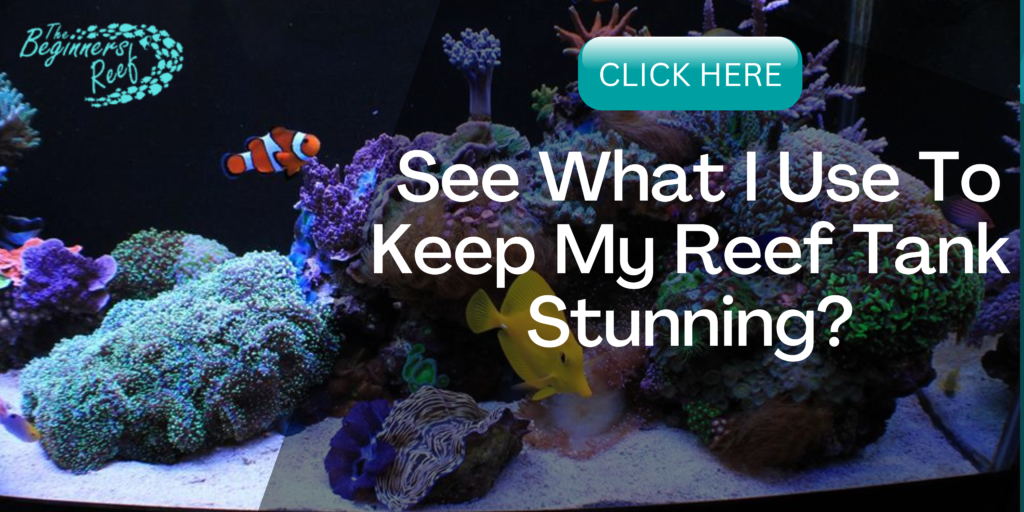Corals! They are what makes a Reef Tank! But they are super hard to keep right? Depends, some are and some are not. This article was put together to help you begin your journey into adding corals to your saltwater aquarium with ease.
The corals I have selected are not just my opinion, but are true, tried and popular selections that thousands of aquarists began with. Many of the corals here, I too began with and are still in my tank today.
19 of the Best Corals for Beginners are:
- Zoanthids
- Mushrooms
- Palythoas
- Toadstools
- Kenya Trees
- Pulsing Xenia
- Green Star Polyps
- Montipora
- Duncan Coral
- Bubble Coral
- Frogspawn Coral
- Candy Cane Coral
- Feather Dusters
- Brian Coral
- Torch Coral
- Hammer Coral
- Blastomussa Coral
- Ricordias
- Birdsnest
It may be tempting to go out and buy the first frag of coral you see, but they will grow and before you know it you will have no room left to add better and more colorful corals in the future. This happened to me!
I ended up having to take out rocks, sell them and then get new rock so I had room to move into SPS corals! Take your time and find the colors, patterns, and shapes that will fit into your idea of a dream aquarium.
Remember, some corals will make it and some corals won’t. You may be able to get a coral to thrive while your friend cannot keep them. Every tank is different and there just may be a coral that you may never be able to keep with your current setup. That’s just the way it is sometimes!
The main thing corals need is water parameter stability. You can view what the ideal parameters to aim for are HERE.
I have started the list here at your tank being 3 months old. By this point you should have made a lot of your rookie mistakes (and hopefully learned from them), you will have a maintenance and water change routine sorted out, you will have a few fish and kept them successfully, you will have had some algae blooms and your bacteria have had a chance to settle in and allow your ecosystem to stabilize.
Now let’s look at 19 of the best beginner corals to start getting some color, movement, and diversity into this glass box of yours!
After Your Tank is 3 Months Old:
Once your tank has hit the 3 month mark the bacteria should be coloinsed enough and your tank cycle has completed. Although you may still be trying to figure out your maintenance routine there are some hardy corals that can tolerate quite abit of water parameter instability and allow you to get started on your coral journey.
Palythoas (Paly’s)
A very hardy coral and a great choice for your first few corals. They can come in a huge range of colors but a lot of them are muted and bland, search out the good ones and leave the junk at the store! You can find some brightly colored ones if you look around. I have some bright pink ones in my tank and each head is about 1/2″ diameter.
They will multiply and spread well once they are happy and established and you can place them next to other Paly’s and Zoa’s to help the colors mix.
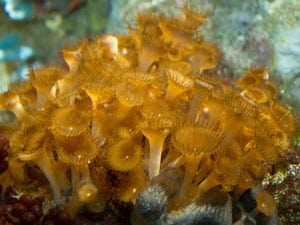
Size: 1/4″ – 2″
Placement: Bottom to Mid Level
Lighting: All Areas. Shady – Full Exposure
Flow: Moderate to High
Food: They gain energy from the light but supplemental feeding of Zooplankton and Phytoplankton will help them grow and spread
A word of caution when you own these corals. SOME carry a deadly toxin called Palytoxin. It is hard to know which contain the toxin and which do not.
>> Click Here to read my article here on Palytoxin Poisoning to help you be aware, recognize the symptoms & what to do if you suspect poisoning <<
Zoanthids (Zoa’s)
Zoa’s are some of my favorite corals. The colors you can find in these are breathtaking. They are super easy to keep, you can place them anywhere, they grow fast and multiply quickly. Many people create entire tanks just of Zoas and they look awesome. I like to use Zoas to fill in the holes between my LPS and SPS corals. They are in the same species of Palythoas so be careful with regard to Palytoxin Poisoning.
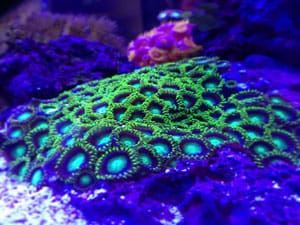
Size: 1/4″ – 3/4″
Placement: Bottom to Top
Lighting: All Areas. Shady – Full Exposure
Flow: Moderate to High
Food: They gain energy from the light but supplemental feeding of Zooplankton and Phytoplankton will help them grow and spread
Mushrooms
Mushrooms are a great beginner coral because they require the least demanding conditions to survive. They do best lower down and with low flow. You can get them in some great patterns and colors.
My favorites are the blue mushrooms and bright orange mushrooms. They grow easily and spread well.
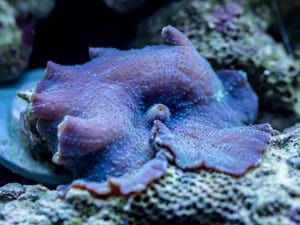
Size: 1/2″ – 3″
Placement: Bottom to Middle
Lighting: Low to Moderate
Flow: Low to Moderate
Food: They gain energy from the light but will capture food from the water. They will eat anything they can capture.
Toadstool Leather Coral
The Toadstool Leather comes in a variety of pastel colors, shapes and can make a nice focal point in any aquarium. The polyps provide a nice motion when irregular flow crosses the coral, even Clownfish have been known to host them.
They can become large and shadow any coral placed underneath them so plan their location before purchase. As they grow they will crease up and create unusual patterns.
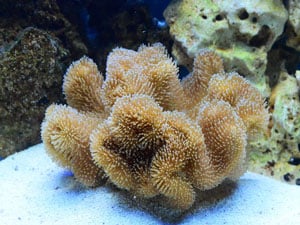
Size: 1″ – 10″
Placement: Middle
Lighting: Moderate to High
Flow: Moderate
Food: They gain most of their energy from the light but will definitely benefit from Phytoplankton feedings
Kenya Tree
As its name suggests it grows like a tree, but this is a beautiful coral full of branches and polyps. It sways back and forth in the current and you can find them in many colors from white, through purple to bright green ($$$ for that one! Been on my list for a while!).
They grow well and will drop branches that will sprout into new corals. Just pick them up and stuff them in a rock hole and you have a new tree. Awesome!
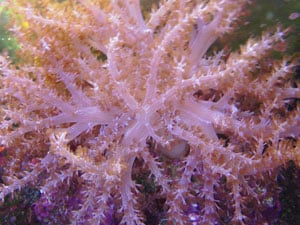
Size: 2″ – 7″
Placement: Anywhere
Lighting: Moderate to High
Flow: Moderate to High
Food: They do require food to be in the water column and supplemental feedings of phytoplankton and Zooplankton will help it thrive
Pulsing Xenia
One of the most mesmerizing corals in our hobby. When you get a mat of these they are just incredible. I have a mat on each end of my reef and I love them. They move by themselves and when placed in a lower flow area will allow you to see them ‘Pulse’!
They grow fast so be sure to control them or you will have a tank full of Pulsing Xenia!
Size: 1″ – 4″
Placement: Bottom to Middle
Lighting: Low to Moderate
Flow: Low to Moderate
Food: They gain most of their energy from the light but will definitely benefit from Phytoplankton & Zooplankton feedings
Green Star Polyps (GSP)
Another very popular and mesmerizing coral, but this one glows neon green under a little bit of actinic light! These individual polyps multiply and grow fast! They will grow on any surface, even the glass.
The waving polyps look like wind blowing over a wheat field when you get good irregular flow on them.
However, they will cover your ENTIRE tank if you let them! Many aquarists keep them on a rock isolated on the sand bed or allow them to cover their back glass and keep them trimmed using a razor blade!
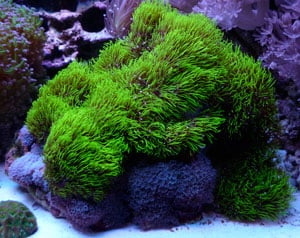
Size: 1/2″ – 1″
Placement: Anywhere
Lighting: Moderate to High
Flow: Moderate to High
Food: They gain most of their energy from the light but will definitely benefit from Phytoplankton & Zooplankton feedings
Frogspawn Coral
Part of the Large Polyp Stony (LPS) family these great corals are super hardy and bring great color to any aquarium. The long tentacles with rounded tips resemble frogspawn, hence their name.
They come in a range of colors from green, pink, purple and orange. They are aggressive towards other corals but can be kept with each other and Hammers and Torches.
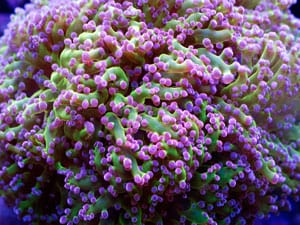
Size: 1″ – 3″
Placement: Middle
Lighting: Moderate to High
Flow: Moderate to High
Food: They gain most of their energy from the light but will definitely benefit from Coral Foods like Reef Roids and Reef Chilli
Hammer Coral
Part of the same Euphyllia family as Frogspawn and Torch family these are another popular LPS beginner coral. I have a Hammer Garden in my reef with Blue, Pink, Yellow, and Green/Purple Hammers all together and they look fantastic when they rock in the flow and intertwine their tentacles.

Size: 1″ – 3″
Placement: Middle
Lighting: Moderate to High
Flow: Moderate to High
Food: They gain most of their energy from the light but will definitely benefit from Coral Foods like Reef Roids and Reef Chilli
Torch Coral
The last coral of the popular Euphyllia species trio. Comprising of long straight tentacles with the tip a different color to the stalk. These really catch the water flow well and when you place several next to each other of varying colors they really do look great.
They come in many colors from green, purple, pink, gold and they grow well.
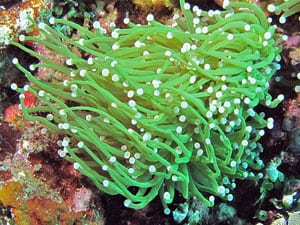
Size: 2″ – 6″
Placement: Middle
Lighting: Moderate to High
Flow: Moderate to High
Food: They gain most of their energy from the light but will definitely benefit from Coral Foods like Reef Roids and Reef Chilli
Bubble Coral
Its name says it all! These bags of water move well in the water flow and it makes a great contrasting coral. They come in shades of white, pink, purple and green and they make very unique focal points in any reef!
Easy to care for and requiring low light make them a good choice for the aquarist on a limited lighting budget.
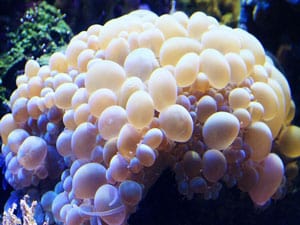
Size: 2″ – 8″
Placement: Bottom – Middle
Lighting: Low to Moderate
Flow: Low to Moderate
Food: They gain most of their energy from the light but will definitely benefit from any food it finds in the water
Feather Duster
I love these little guys! So fun to watch them pull their feather duster crown back into their tube when touched or harassed. This is actually a worm that builds a tube and extends its feathered crown to catch food from the water column and move it towards its central mouth. It can drop its crown if stressed, but it soon grows back! Even though this is not actually a coral, it’s a great addition for the beginner!
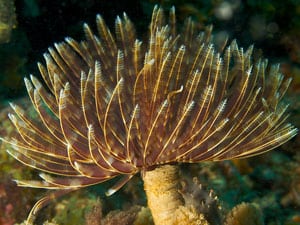
Size: 1″- 7″
Placement: Bottom
Lighting: Low
Flow: Moderate
Food: Supplemental feedings of Zooplankton, Phytoplankton, Reef Roids, Reef Chilli or anything you can get your hands on!
After Your Tank is 6 Months Old:
Your aquarium is starting to settle down and find its natural balance. Your water parameters should becoming more stable and your maintenance routine is getting dialed in. You can now begin to start adding corals that require a little more stability and care.
Candy Cane Coral
This branching coral has large inflated fleshy heads with tentacles that trap food. They can be aggressive to neighbors, so keep them a few inches away from other corals.
They can be found in shades of pink, blue, purple, green and neon green. They multiply well when they are happy and are a great addition to any reef.
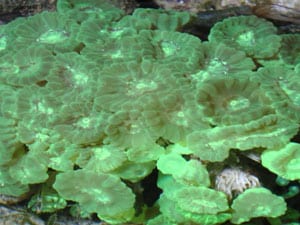
Size: 1″ – 3″
Placement: Bottom – Middle
Lighting: Low – Moderate
Flow: Moderate
Food: They gain most of their energy from the light but will definitely benefit from Phytoplankton & Zooplankton feedings
Blastomussa (Blasto’s)
Blasto’s are another of my personal favorite beginner corals because they are so easy and so pretty. These are a good coral to get once you have started to get things figured out and are wanting to try something different.
They like low to moderate lighting and flow. If you find the fleshy heads are not opening you may have them in a place that is too bright or too much flow.
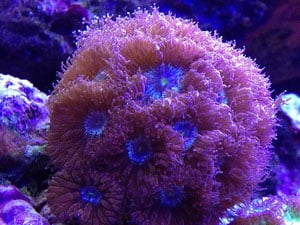
Size: 1″ – 3″
Placement: Bottom – Middle
Lighting: Low – Moderate
Flow: Moderate
Food: They gain most of their energy from the light but will definitely benefit from additional feedings of coral food to help speed up growth
Brain Coral
A good beginner LPS coral full of pattern and color. They come in a wide variety of colors and they are stunning. Keep them on the sand bed and away from other corals as they have sweeper tentacles that will sting neighbors if they are too close. They are slow growers be very resilient if you have stable water parameters.
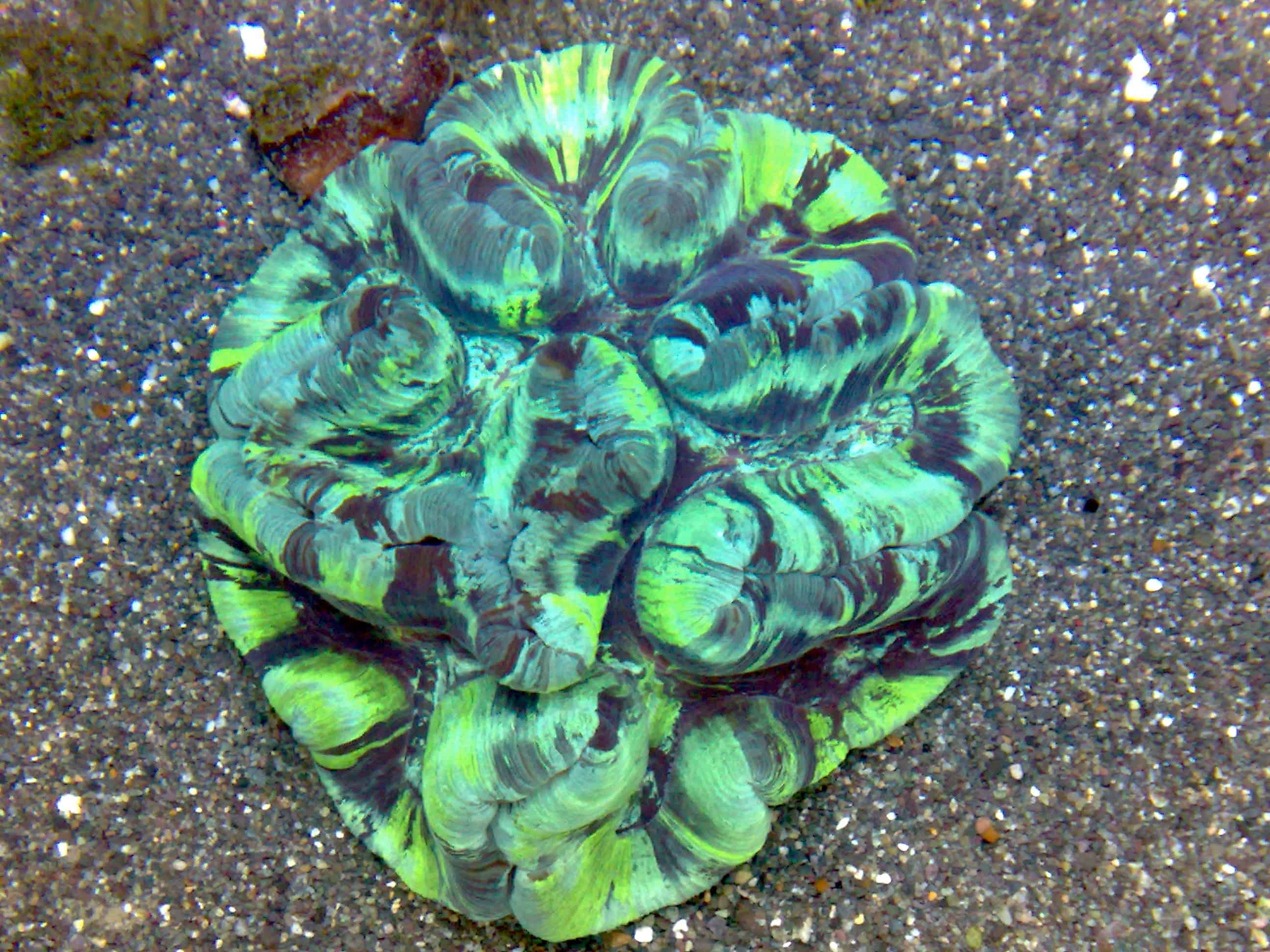
Size: 1″ – 7″
Placement: Bottom
Lighting: Moderate
Flow: Moderate
Food: They gain most of their energy from the light but will definitely benefit from feedings of Zooplankton
Ricordia
I love the color and bubbles on Ricordias. The colors you can find them in making them perfect for creating a ‘Ric Garden’. Easy to care for once you have your parameters stable and will reproduce easily when happy.
They require good light and flow, but not being blasted by a powerhead. They will soon become a favorite of yours once you start to collect a couple and you see how they contrast from one another.
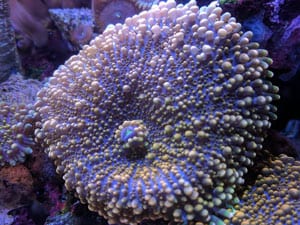
Size: 1/2″ – 2″
Placement: Bottom – Middle
Lighting: Moderate – High
Flow: Moderate
Food: They gain most of their energy from the light but will definitely benefit from feedings of Zooplankton
Duncans
Duncans are a nice addition to your aquarium with the colors and movement in the flow. They branch off and form new heads and a large colony looks great. When they are happy they grow and multiply quickly with minimal attention. They like high light and flow.
You can find them with green, pink, purple, blue and cream color variations and adding them close to one another makes really nice focal points.
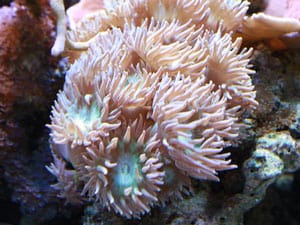
Size: 1/2″ – 2″
Placement: Middle
Lighting: Moderate – High
Flow: High
Food: They gain most of their energy from the light but will definitely benefit from feedings of anything meaty!
Birdnest
Birdsnest Coral is one of the easiest SPS corals to keep. It is a great beginner coral and introduction into seeing if your water is stable enough to add SPS further down the line.
The Birdsnest is a tree-like coral that grows multiple pointy branches and comes in pinks, greens, and purples. It grows fast when it is happy and frags really well.
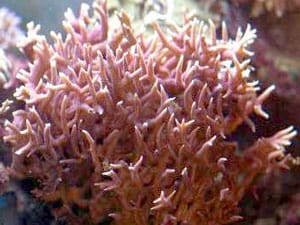
Size: 1/2″ – 8″
Placement: Middle – Top
Lighting: Moderate – High
Flow: Moderate – High
Food: They gain most of their energy from the light but will benefit from feedings of Zooplankton, Phytoplankton & other coral foods
Montipora
I think everyone is familiar with Monitpora Coral. The ‘Dinner Plates’ that grow and shadow everything. They are another great beginner introduction into SPS as they grow well, grow fast and are usually the first frags that you can sell. I have pink, green and purple Monit’s in my tank and the pink and green ones are bright neon! They are awesome.
Be careful where you place them as they will cut off the light to everything underneath it as it grows. I have mine on the ends of my tank and my shrimp like to hang out under them.
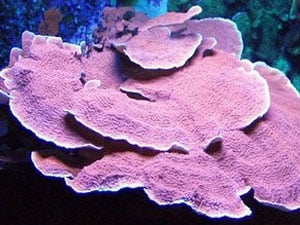
Size: 1/2″ – 12″
Placement: Middle – Top
Lighting: Moderate – High
Flow: Moderate – High
Food: They gain most of their energy from the light but supplemental feedings will speed up their growth
When Can I Add my First Corals?
This hobby is all about keeping water, not livestock. If you can keep good water, then you can keep anything providing the conditions are right. Good flow and powerful light are essential when you first get into corals and its a case of buying the good equipment once rather than buy junk first, then the good stuff later!
It is best to add your first coral after 3 months of starting the tank and you have sufficient light and flow for the corals you wish to keep. After 3 months the water paramaters are beginning to stabilize and the maintenance routine should be regular. Soft corals are the best to begin with.
In your first few months just get your routine down and practice keeping your water parameters stable. You will go through algae blooms and that’s just part of the natural growth of a reef tank. In fact, I’m battling Bubble Algae right now but the Foxface I purchased is destroying it!
Corals are no harder to keep than your fish, just take your time and don’t be in a rush to fill your tank. Leave the top half of your rock free for the nicer and harder to keep corals as both you and your tank mature.
When you first get your corals I suggest placing them on the sand bed for a few days to allow them to acclimatize to your flow and lights. Corals that turn brown or white are being exposed to too much light too soon and need to place more in the shade.
Have fun, take your time and go and buy some frags of the coral mentioned above and see how you go!
If you would like to know abit more indepth about when is the best time to begin adding your first corals please check out these articles:
Where Do You Buy Corals From?
Corals can be bought from many places in the US. Your local saltwater fish store, corals meet events and online coral suppliers. All corals bought online are be shipped next-day delivery in insulated boxes with heat/cool packs installed depending on the climate.
Living in the US we have access to some of the most stunning corals available and the one supplier I highly recommend you check out is the online store of Unique Corals. Backed by the biggest names in the industry, Joe and his team at Unique Corals have some of the highest customer satisfaction scores you will ever find and they are the reason why I’ve teamed up with them.
Their online store allows you to see the EXACT coral frag that you are going to receive and you can grab some absolute bargains on some incredible pieces. Their fast shipping, excellent customer service, and 7-day guarantee mean you will have healthy specimens at your door in no time! I have been ordering corals online for years and it is so simple and stress-free!
To View Unique Coral’s Incredible Coral Selection Available For You & See Their Latest Deals At Their Online Store:
>>>> Unique Coral’s Online Store – Click Here <<<<
Once you have either bought or been given your first coral frags I highly suggest you dip them and give them a really good inspection before placing them in your aquairum. Doing this will prevent any corals pests from getting into your aquarium and creating a disaster.
To help you I have created this simple, step-by-ste guide for you to follow:
How To Dip Corals – Easy Steps To Success
Planning which corals to start with is a fun process, but you may also find these other articles helpful too:

